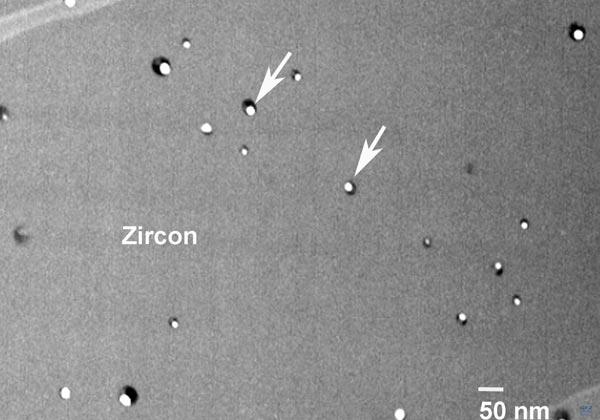Lead hokes the Age

Zircon from East Antarctica with nanospheres of metallic lead under GFZ’s transmissionelectron-microscope TEM. The rock sample is more than 3,4 billion years old. Photo: GFZ
Rocks do not loose their memory during Earth history but their true ages might be distorted: even under ultra high-temperature metamorphic conditions exceeding 1200°C zircon maintains its lead content accumulated during radioactive decay of uranium and thorium.
Giga year old zircon crystals still contain lead in form of nanometre size spheres of pure lead. However, the inhomogeneous spatial distribution of the lead spheres might falsify ages determined from high-resolution Pb isotope measurement with ion probe.
Zircon is an ideal mineral for age determination of very old rocks because it is believed to be a closed system during Earth history.
Zircon geochronology thus is a standard method of geological age determination. Recently, an international group of earth scientists studied zircon from 3,4 billion years old high-temperature metamorphic rocks from Antarctica with transmission electron microscopy TEM at the GFZ German Research Centre for Geosciences.
TEM investigations revealed that the lead from radioactive decay was not homogeneously distributed in zircon but was accumulated withinin inhomogeneously distributed Pb nano-spheres in zircon with only 5 to 30 nm in diameter.
The inhomogeneous distribution of lead in zircon might adulterate the ages measured with high-spatial resolution ion probe technique.
Monika A. Kusiak et al.: “Metallic lead nanospheres discovered in ancient zircons”, Proceedings of the National Academy of Sciences, PNAS Early Edition, 06.04.2015, DOI: doi/10.1073/pnas.1415264112
Media Contact
More Information:
http://www.gfz-potsdam.de/All latest news from the category: Earth Sciences
Earth Sciences (also referred to as Geosciences), which deals with basic issues surrounding our planet, plays a vital role in the area of energy and raw materials supply.
Earth Sciences comprises subjects such as geology, geography, geological informatics, paleontology, mineralogy, petrography, crystallography, geophysics, geodesy, glaciology, cartography, photogrammetry, meteorology and seismology, early-warning systems, earthquake research and polar research.
Newest articles

Superradiant atoms could push the boundaries of how precisely time can be measured
Superradiant atoms can help us measure time more precisely than ever. In a new study, researchers from the University of Copenhagen present a new method for measuring the time interval,…

Ion thermoelectric conversion devices for near room temperature
The electrode sheet of the thermoelectric device consists of ionic hydrogel, which is sandwiched between the electrodes to form, and the Prussian blue on the electrode undergoes a redox reaction…

Zap Energy achieves 37-million-degree temperatures in a compact device
New publication reports record electron temperatures for a small-scale, sheared-flow-stabilized Z-pinch fusion device. In the nine decades since humans first produced fusion reactions, only a few fusion technologies have demonstrated…





















